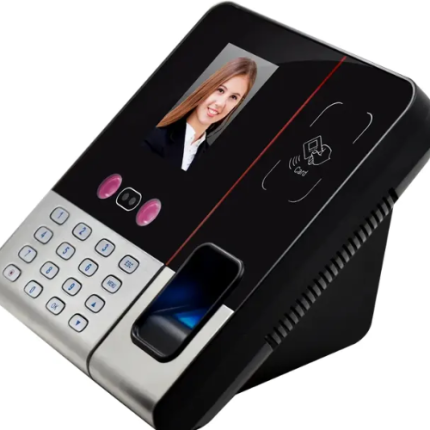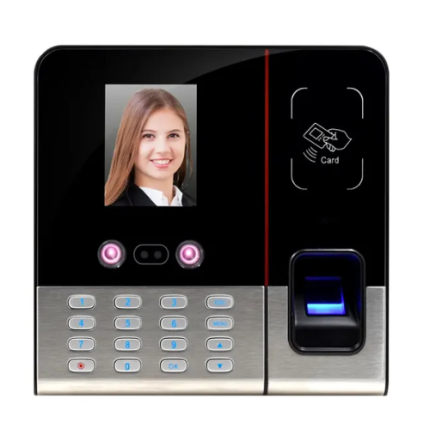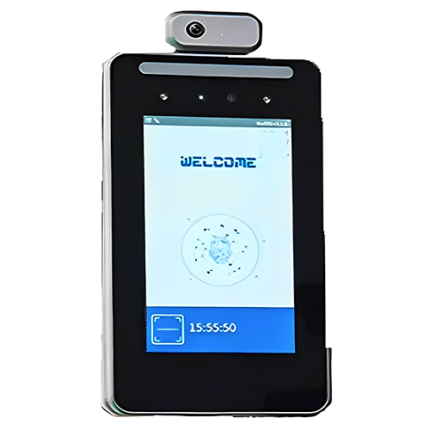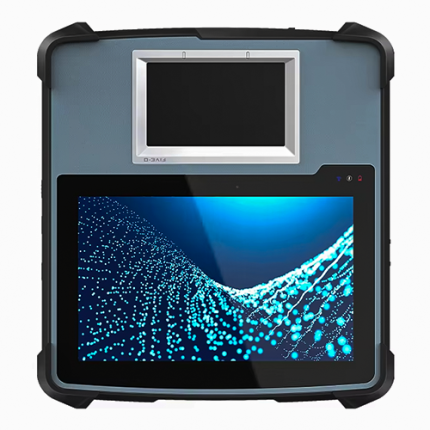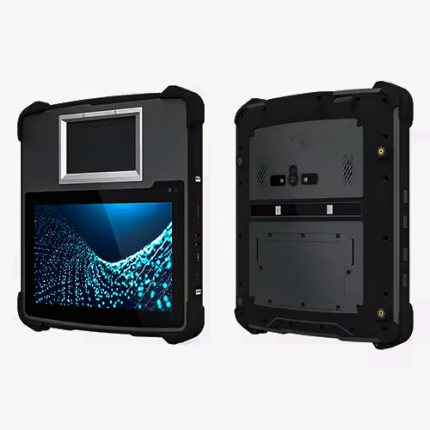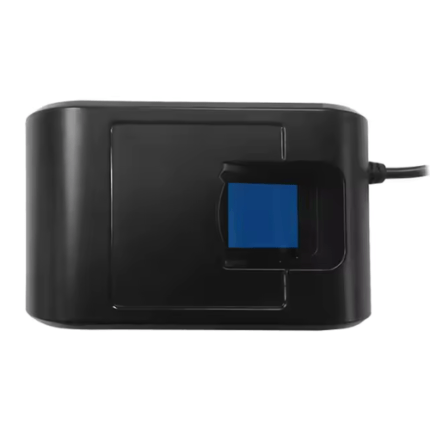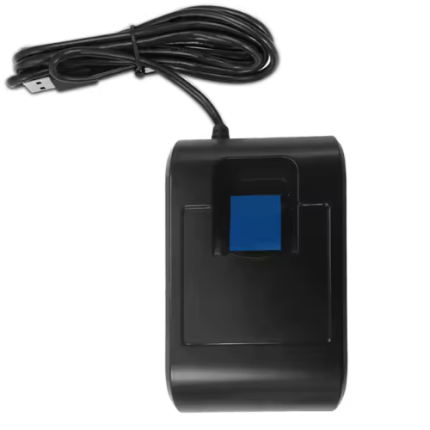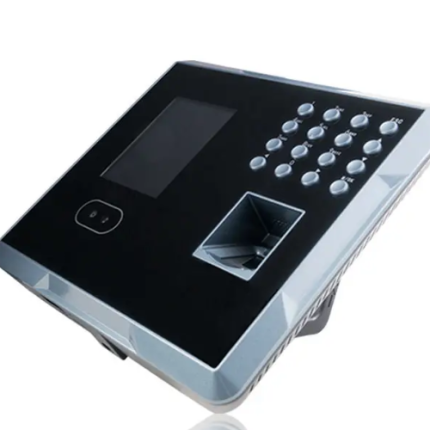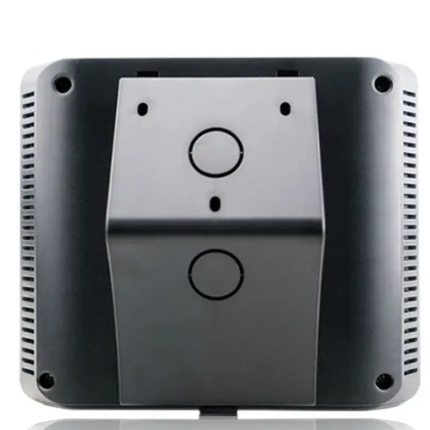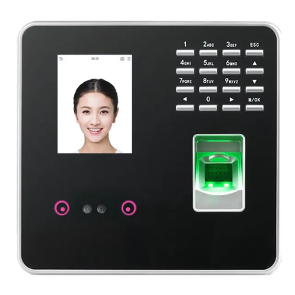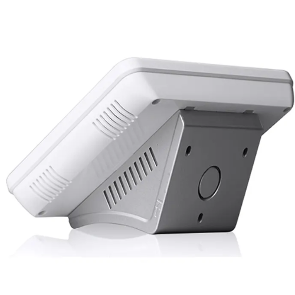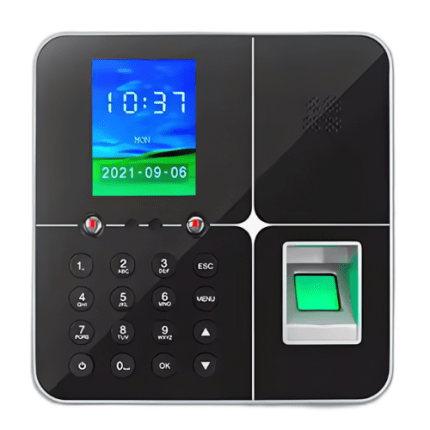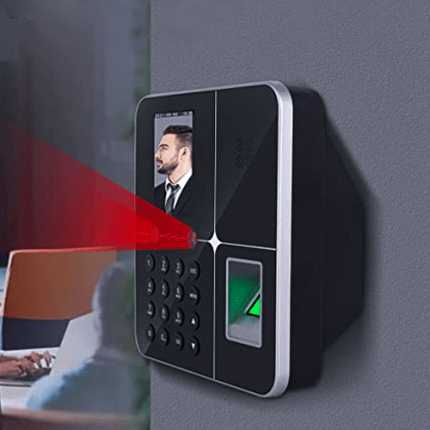Overview
The Industrial Internet of Things (IIoT) is revolutionizing various industries by enabling seamless connectivity between devices, advanced data analytics, and automation. In the realm of biometrics, IIoT enhances the functionality and efficiency of systems used for identity verification, access control, and workforce management. Through real-time monitoring and data processing, IIoT-integrated biometric technologies provide unparalleled security and operational efficiency in industrial environments.
Biometric systems utilize unique physical and behavioral traits, such as fingerprints, facial features, and iris patterns, to authenticate identities and protect sensitive assets. When combined with IIoT, these systems gain capabilities such as remote monitoring, automated alerts, and integration with broader industrial workflows. Applications span from managing secure access to tracking attendance and safeguarding high-value assets, ensuring that operations remain efficient and compliant with security standards.
Key IIoT technologies driving advancements in biometrics include LoRaWAN for long-range, low-power communication, ZigBee for mesh networking in industrial setups, and Wi-Fi HaLow for high-bandwidth applications. Additionally, RFID and Bluetooth Low Energy (BLE) technologies support secure and efficient biometric data transfer and device connectivity, even in challenging industrial conditions.
While the integration of IIoT into biometric systems offers significant benefits, such as enhanced security, operational efficiency, and real-time data analytics, challenges remain. These include addressing data privacy concerns, managing scalability, and ensuring systems are robust enough to withstand harsh environmental conditions. Despite initial implementation costs, IIoT-enabled biometric solutions are a long-term investment in productivity, security, and compliance.
This guide delves into the technologies, applications, benefits, and challenges associated with IIoT-driven biometric systems. It highlights how these innovations are transforming industrial operations and provides insights for businesses aiming to adopt cutting-edge biometric solutions tailored to their needs.
Below are products and systems related to this webpage:
Our products are in stock and can be shipped overnight to Continental U.S. and Canada from one of our local warehouses. If you have any questions, our technical experts can help you. Please fill out this form or email us.
We are actively looking for partners who are like us located in the U.S. and Canada. For more information on partnering with GAO, please visit Partner with GAO Tek Inc. It lists various ways to partner with GAO, such as OEM Partnerships, Technology Integration, Distribution and Reselling Opportunities, Presenting at the Leading Event Tek Summit, Joint R&D Projects, Training and Consulting Services, Industry-Specific Collaborations, Research and Academic Partnerships.
1.Definition and Significance of Industrial IoT in Biometrics
The Industrial Internet of Things (IIoT) is transforming various sectors by connecting industrial equipment and technologies, streamlining processes, and enabling remote control and real-time data analytics. In the field of biometrics, IIoT enhances biometric systems by adding seamless connectivity and intelligence, optimizing them for industrial applications such as access control, employee attendance, and asset security. At GAO Tek Inc, headquartered in New York City and Toronto, Canada, we understand that as companies adopt biometric systems to improve security and efficiency, IIoT integration provides the opportunity to capture and process biometric data in real time. This ability to monitor and analyze physical and behavioral traits securely and remotely is pivotal for industries relying on identity verification, security, and compliance.
The significance of IIoT in biometrics extends beyond mere convenience; it enables industries to strengthen operational security, automate routine checks, and increase overall productivity. GAO Tek is committed to supporting businesses that adopt IIoT-enabled biometric systems by offering cutting-edge technologies that capture, process, and analyze biometric data with unparalleled accuracy and efficiency. With our decades of experience in advanced technologies for industrial applications, GAO Tek ensures that these systems not only integrate seamlessly but also adapt to evolving security standards.
Introduction of Biometrics in Industrial Applications
Biometrics involves measuring unique physical or behavioral characteristics of individuals, such as fingerprints, iris patterns, and facial recognition, to authenticate identities. In industrial settings, biometric technologies are essential for ensuring secure access control, monitoring workforce attendance, and protecting high-value assets. From manufacturing facilities to government institutions, biometrics help control access to sensitive areas, reduce workplace fraud, and ensure that only authorized personnel handle equipment or sensitive information.
GAO Tek supports various biometric technologies that meet the rigorous demands of industrial environments. For instance, rugged biometric scanners equipped with IIoT functionality can withstand harsh conditions, from extreme temperatures to dust and moisture. With GAO Tek’s stringent quality assurance processes and a focus on robust R&D, our IIoT-enabled biometric solutions are trusted by Fortune 500 companies and government agencies across the U.S. and Canada.
Benefits and Challenges of Integrating IoT in Biometric Systems
Benefits
- Enhanced Security: IIoT-enabled biometric systems improve security by providing real-time monitoring and alerting. The connected nature of IIoT means that, if a security breach is attempted, instant notifications can be sent to centralized systems or mobile devices, allowing quick responses and minimizing risk.
- Operational Efficiency: Automating access control and time-tracking with biometric systems reduces the need for manual checks, saving time and reducing operational costs. For industries with large workforces, IIoT-integrated biometric systems streamline processes, allowing organizations to allocate resources more effectively.
- Data Analytics and Reporting: With IIoT, biometric systems not only capture data but also store, analyze, and report on it in real time. This continuous flow of information enables organizations to monitor trends, optimize workflows, and proactively address any issues related to employee productivity or security protocols. GAO Tek’s biometric solutions are designed to seamlessly connect with a company’s analytics platforms, ensuring that decision-makers have immediate access to actionable insights.
- Remote Management and Troubleshooting: IIoT-enabled biometrics allow IT and security teams to remotely manage systems, addressing issues without needing to be on-site. With GAO Tek’s expert support, offered both remotely and onsite, our clients benefit from proactive maintenance and prompt issue resolution, keeping their operations running smoothly and securely.
Challenges
- Data Privacy and Security Concerns: Integrating IIoT with biometrics can introduce privacy risks, as personal data is transmitted across networks. This makes these systems a target for cyber-attacks, necessitating robust encryption and access management protocols. GAO Tek implements advanced security protocols in all our biometric solutions, ensuring data protection compliance with regulatory standards.
- Scalability Issues: For large organizations, scaling an IIoT-based biometric solution to accommodate thousands of users while maintaining speed and accuracy can be challenging. GAO Tek has invested heavily in R&D to ensure that our systems are scalable and reliable, supporting industries of all sizes, from small firms to large enterprises.
- High Implementation Costs: Although IIoT offers significant long-term savings, the initial costs of implementing IIoT-integrated biometric systems can be high. However, GAO Tek provides customized solutions to help our clients achieve a balance between affordability and functionality, creating solutions that fit their unique operational requirements.
- Environmental Constraints: Biometric systems in industrial environments must withstand harsh conditions, such as extreme temperatures and dust. GAO Tek’s biometric devices undergo rigorous environmental testing, ensuring they are durable and reliable for a variety of industrial applications.
2. Key Technologies Enabling IIoT in Biometrics
LoRaWAN (Long Range Wide Area Network)
Overview and Functionality
LoRaWAN (Long Range Wide Area Network) is a wireless communication protocol designed for long-range, low-power IoT applications. It utilizes sub-gigahertz radio frequencies to transmit small amounts of data over distances reaching up to 10 miles in rural areas and 1–2 miles in urban settings. For IIoT, LoRaWAN provides a reliable means of connecting biometric devices in environments where wired connectivity is impractical.
Applications in Remote Biometric Data Collection
LoRaWAN’s capabilities are ideal for collecting biometric data in remote and dispersed locations, such as mining sites or vast industrial complexes. By transmitting information over long distances without the need for constant internet access, LoRaWAN supports real-time monitoring of identity verification, attendance, and location-based access control.
Pros and Cons for IIoT Biometrics
Pros:
- Extended Range: Effective in covering vast areas, making it suitable for remote industrial sites.
- Low Power Consumption: Supports battery-operated devices for prolonged use.
- Scalability: Can manage thousands of connected devices.
Cons:
- Limited Bandwidth: Not suitable for large data transfers, such as high-resolution images.
- Latency: Not ideal for real-time applications that require immediate response.
ZigBee
Overview and Use Cases
ZigBee is a low-power, short-range wireless technology operating in the 2.4 GHz frequency band. Its mesh networking capabilities allow it to connect numerous devices within proximity, making it effective in factory or warehouse environments for biometric device integration.
Role in Connecting Biometric Devices
With its ability to form mesh networks, ZigBee can interconnect biometric devices across complex industrial settings, such as manufacturing plants or storage facilities. GAO Tek’s ZigBee-enabled solutions facilitate seamless device-to-device communication, creating a reliable biometric network that supports controlled access and employee monitoring.
Advantages in Low-Power Environments
ZigBee’s low-power consumption extends battery life, which is beneficial for IIoT applications where devices may not have constant power access. For instance, portable fingerprint scanners or wearable biometric devices are ideal for ZigBee integration.
Wi-Fi HaLow
Features and Benefits for Biometrics
Wi-Fi HaLow, operating on the sub-1 GHz spectrum, provides longer range and better penetration through obstacles than traditional Wi-Fi. It is ideal for high-bandwidth environments where biometric devices require continuous data transmission and a reliable connection.
Suitability in High-Bandwidth Environments
Wi-Fi HaLow’s capabilities make it suitable for environments that demand large data throughput, such as biometric facial recognition systems or high-resolution fingerprint scanners. GAO Tek’s Wi-Fi HaLow solutions help clients maintain seamless, high-speed connectivity for their biometric devices, ensuring optimal performance in dense industrial settings.
Z-Wave
Overview, Applications, and Limitations
Z-Wave is a wireless communication protocol known for its interoperability with smart home and industrial automation systems. Operating on a low-frequency band (around 900 MHz), it enables communication between devices within a 100-meter range.
Ideal Scenarios for Z-Wave in IIoT Biometric Devices
Z-Wave’s low interference and device compatibility make it ideal for small-scale biometric networks in confined spaces, such as controlled-access storage rooms or laboratories. However, it may not be suitable for larger industrial sites due to its limited range and bandwidth.
Bluetooth Low Energy (BLE)
Overview of BLE in Biometric Data Transfer
Bluetooth Low Energy (BLE) offers low-power, short-range communication, making it ideal for wearable biometric devices and smartphones. BLE transmits data quickly and efficiently while consuming minimal power.
Range, Power Consumption, and Practical Examples
With a range of 10–30 meters, BLE is practical for biometric applications that require quick data exchange, such as fingerprint authentication on mobile devices or workforce attendance tracking via wearable devices. At GAO Tek, we leverage BLE for its convenience in short-range IIoT biometric applications, ensuring our clients benefit from reliable, efficient data transfer without high power demands.
RFID (Radio-Frequency Identification)
Use of RFID for Identity and Access Control in Biometrics
RFID technology uses electromagnetic fields to identify and track tags attached to objects. In biometrics, RFID is essential for identity and access control, allowing secure entry to facilities by scanning RFID-enabled biometric ID cards or tags.
Applications in IIoT Asset Tracking and Monitoring
RFID technology in IIoT facilitates not only identity verification but also asset tracking, enabling industries to monitor the location and status of valuable equipment. GAO Tek’s RFID solutions are robust, supporting large-scale asset management for clients in logistics, manufacturing, and beyond.
Narrowband IoT (NB-IoT)
Importance for Remote and Wide-Area Biometric Devices
NB-IoT is a cellular LPWAN technology that provides long-range connectivity and ultra-low power consumption, making it well-suited for remote biometric applications. NB-IoT can operate in areas with poor cellular coverage, such as underground facilities or remote industrial zones.
Benefits of NB-IoT in Low-Power, Wide-Area Applications
NB-IoT’s low power consumption ensures extended battery life for biometric devices in remote locations, while its wide area coverage supports reliable connectivity. GAO Tek integrates NB-IoT into devices that monitor employee access and attendance in remote facilities, ensuring seamless data transmission even in low-signal areas.
Cellular IoT (LTE-M, 5G)
Benefits of Cellular Connectivity in Mobile Biometrics
LTE-M and 5G provide cellular connectivity with the necessary bandwidth for mobile biometric devices, offering reliable, fast communication. LTE-M offers extended coverage and low-power operation, while 5G supports real-time data transmission for applications requiring instantaneous responses.
5G’s Impact on Real-Time Data and Analytics
5G’s low latency and high data rate make it transformative for real-time biometric data analytics, enabling immediate processing of large biometric datasets such as facial recognition or iris scans. GAO Tek’s 5G-enabled solutions ensure that our clients can leverage advanced biometric applications with minimal delay, enhancing security and operational efficiency.
GPS IoT
Role of GPS in Geolocation and Tracking of Biometric Devices
GPS technology provides precise geolocation data, crucial for tracking mobile biometric devices used in industrial settings. GPS -enabled biometric devices can verify and log the location of employees, ensuring compliance with safety protocols in geofenced areas.
Applications in Mobile Workforce Biometrics
For companies managing a mobile workforce, GPS-integrated biometric devices help track employee movements, provide location-based access, and secure equipment across distributed sites. GAO Tek’s GPS IoT solutions offer industries the tools to manage and secure their workforce effectively, promoting transparency and safety.
3. IoT Sensors in Biometrics
Types of Sensors in IIoT Biometrics
IoT sensors are the backbone of biometric systems in industrial applications, capturing diverse data types to enable real-time processing and analysis. Different sensor types serve specific roles in collecting biometric data, each chosen based on the environment and the unique requirements of the industrial setting.
Environmental Sensors
Environmental sensors monitor surrounding conditions, including humidity, light levels, and air quality. In biometric systems, they help ensure that the surrounding environment is optimal for data collection. For example, certain environmental factors like humidity and temperature can impact fingerprint recognition accuracy. At GAO Tek Inc., our environmental sensors are meticulously designed to improve the accuracy of biometric readings by maintaining a stable environment.
Pressure Sensors
Pressure sensors detect force, often employed in fingerprint and hand geometry recognition systems. By measuring the pressure exerted on the sensor, these devices can differentiate between actual human contact and other objects, reducing false positives. This is particularly useful in industrial settings with high security, such as restricted lab areas or data centers.
Motion Sensors
Motion sensors, such as accelerometers and gyroscopes, play a significant role in monitoring movement and behavior for applications like access control and workforce management. They can detect body posture and gait, which are valuable in biometric analysis to prevent unauthorized access and to monitor personnel activity within high-security zones.
Temperature Sensors
Temperature sensors detect and monitor body temperature, useful for verifying the presence of a living person during biometric verification, especially in facial and iris recognition systems. Temperature readings help authenticate live subjects, enhancing security by detecting spoofing attempts in biometric systems. GAO Tek’s range of temperature sensors is optimized for biometric applications, delivering high accuracy even in challenging industrial environments.
Sensor Applications in Biometric Data Collection and Processing
In IIoT biometric systems, these sensors capture a wide variety of data, feeding it into the cloud or edge computing platforms for real-time processing. This capability is instrumental in facilitating the following applications:
- Identity Verification: Using pressure and motion sensors, biometric systems can authenticate personnel based on physical characteristics, such as fingerprints or gait, ensuring only authorized individuals gain access to secure areas.
- Behavioral Analysis: Environmental and motion sensors can track employee activity and behavior within industrial facilities, creating an additional layer of security. For example, if an employee deviates from typical behavior patterns, the system can trigger an alert for further verification.
- Workforce Health Monitoring: Temperature sensors enable real-time health monitoring, helping to ensure employees entering facilities are not displaying signs of illness. These biometric systems aid compliance with health protocols, a priority in industrial settings.
Challenges of Integrating and Managing IoT Sensors in IIoT
Despite the potential benefits, implementing and managing IoT sensors for biometrics in IIoT environments poses several challenges, especially in complex industrial settings.
Data Volume and Processing
IoT sensors continuously generate vast amounts of data, which require efficient processing and storage solutions. In biometrics, the data collected from multiple sensors, including image and environmental data, demands significant computational power. Without proper management, this can lead to data bottlenecks, affecting the responsiveness of biometric systems. GAO Tek addresses this challenge with advanced data management solutions that streamline processing and ensure the timely delivery of actionable insights.
Interoperability and Compatibility
Another significant challenge lies in ensuring that different types of IoT sensors are interoperable within a single biometric system. This is particularly important in IIoT, where various biometric devices may need to interact seamlessly. Ensuring compatibility across sensor types, protocols, and software systems requires careful selection and configuration of components. GAO Tek leverages its extensive industry experience and close relationships with leading technology providers to help clients deploy interoperable and integrated IIoT biometric systems.
Environmental Conditions and Sensor Durability
Industrial environments are often harsh, with exposure to dust, extreme temperatures, and electromagnetic interference, which can affect sensor performance and longevity. Biometric sensors in such environments require protection against these factors to maintain reliable operation. GAO Tek offers sensors with ruggedized designs, ensuring reliability and durability even in challenging industrial conditions.
Data Security and Privacy
With biometric data being highly sensitive, ensuring secure data transmission and storage is paramount. IoT sensors transmit biometric data over networks that must be safeguarded against cyber threats. Secure data management and end-to-end encryption are essential to prevent unauthorized access and data breaches. GAO Tek’s IIoT biometric solutions incorporate robust security protocols and comply with stringent privacy regulations to protect user data throughout its lifecycle.
4. Environmental Testing for Biometric Devices in IIoT
Importance of Environmental Durability in IIoT Biometric Sensors
In the Industrial Internet of Things (IIoT), biometric devices face challenging conditions, requiring durability and resilience against environmental factors to ensure long-term reliability. Environmental durability is crucial for biometric sensors as they frequently operate in harsh settings where extreme temperatures, high humidity, and physical impacts are common. If sensors lack the durability to withstand these conditions, they risk frequent failures, leading to costly maintenance and potential security breaches.
GAO Tek Inc., headquartered in New York City and Toronto, recognizes the need for robust and resilient biometric devices in industrial environments. By prioritizing environmental durability in our product development, we deliver sensors capable of maintaining performance and accuracy across a range of adverse conditions. Our rigorous testing processes ensure that each device meets high standards for durability, aligning with our commitment to quality and reliability, a standard we’ve upheld for over four decades in serving U.S. and Canadian industries.
Common Environmental Tests for IIoT Biometric Devices
Temperature Testing
Temperature extremes are a fundamental concern for IIoT biometric sensors, as exposure to either extreme heat or cold can lead to degradation in sensor accuracy and even complete failure. Temperature testing typically involves subjecting devices to extreme temperatures within controlled environments, simulating potential field conditions. Sensors are evaluated for their tolerance to both short-term and long-term temperature fluctuations to verify operational stability.
GAO Tek’s biometric sensors are rigorously tested to ensure resilience under fluctuating and extreme temperature conditions, maintaining functionality even in challenging industrial settings. For instance, sensors used in warehouses or outdoor facilities may experience high heat, while those in cold storage or arctic regions face sub-zero temperatures, both of which our devices are engineered to endure.
Humidity Testing
Humidity can also compromise sensor performance, especially in regions or industrial processes where high moisture levels are common. Humidity testing measures a device’s resistance to moisture, assessing its performance under both high and variable humidity conditions. Prolonged exposure to high humidity can cause corrosion and degradation, especially in sensitive electronics, making this test essential for long-term reliability.
GAO Tek conducts rigorous humidity testing to prevent such failures, ensuring our sensors operate seamlessly in humid environments like manufacturing plants, food processing facilities, and regions with variable seasonal climates. Our products are designed with moisture-resistant features that minimize damage risks, enabling reliable biometric performance across diverse applications.
Shock and Vibration Testing
In industrial environments, biometric devices often experience significant shock and vibration from nearby machinery or due to accidental drops. Shock and vibration testing simulate the physical impacts and continuous vibrations that devices may encounter, evaluating their structural integrity and ability to maintain functionality. High vibrations, particularly in factories or transport vehicles, can interfere with device components, risking mechanical or electronic failures.
GAO Tek incorporates shock and vibration-resistant designs in our IIoT biometric devices, validated through robust testing. This ensures that our sensors can withstand rigorous conditions while continuing to provide accurate biometric data. This testing is particularly important for devices installed in high-mobility environments, like transportation hubs or industrial production lines.
Ensuring Sensor and Device Reliability in Industrial Environments
The ultimate goal of environmental testing is to guarantee sensor reliability, ensuring that devices consistently perform regardless of environmental challenges. For industrial IoT biometrics, device reliability is synonymous with security, efficiency, and reduced downtime.
At GAO Tek, we emphasize stringent quality assurance processes, performing exhaustive environmental testing on all biometric products to confirm operational reliability and adherence to industry standards. This includes testing each sensor and component individually, simulating diverse environmental scenarios, and ensuring that our devices are equipped to perform in varied industrial applications. Our clients, including Fortune 500 companies and government agencies, rely on our solutions for secure, accurate biometric identification in high-demand settings.
With expertise derived from four decades of research and development, GAO Tek not only provides durable biometric sensors but also delivers expert support to our customers, ensuring they have dependable technology solutions that meet their exact requirements. This commitment to durability and quality reflects our role as a leading supplier in advanced IIoT biometric systems, offering products engineered for the toughest industrial environments.
5. Edge Computing in IIoT Biometrics
Overview of Edge Computing for Real-Time Data Processing
Edge computing refers to the practice of processing data closer to the source—at the “edge” of the network—rather than relying solely on centralized cloud servers. In the context of Industrial Internet of Things (IIoT) biometrics, edge computing allows biometric data to be captured, processed, and analyzed in real time, at or near the device level. This is particularly essential in environments where latency and bandwidth limitations are critical concerns.
By deploying edge computing capabilities in biometric systems, the process of authentication and verification can happen instantly, without the need for data to be sent back and forth to a remote data center. This significantly enhances the speed and responsiveness of biometric solutions, which is essential in high-stakes, high-traffic scenarios such as access control, workforce management, and security applications.
At GAO Tek Inc., we leverage edge computing in our biometric solutions to ensure that data processing occurs in real-time, improving both system efficiency and user experience. Our state-of-the-art devices and systems are designed to optimize local data processing, reducing reliance on cloud infrastructure and providing faster, more reliable results.
Benefits of Edge Computing in Biometrics
Latency Reduction
One of the primary benefits of edge computing in biometric systems is the dramatic reduction in latency. Latency refers to the time delay between data capture and response. In traditional biometric systems, data often needs to be transmitted to centralized servers for processing, which can introduce delays. With edge computing, biometric data is processed locally, ensuring faster responses for tasks such as facial recognition, fingerprint scanning, and voice identification.
In industrial environments, where real-time processing can be the difference between operational efficiency and costly delays, edge computing enables instantaneous biometric authentication and monitoring. This is particularly beneficial in applications like employee access control or time-tracking systems, where speed and accuracy are paramount.
At GAO Tek, we integrate edge computing in our biometric systems to provide near-instantaneous response times, making sure our solutions meet the high-performance demands of industrial environments.
Enhanced Security
Another key advantage of edge computing is enhanced security. In traditional cloud-based systems, sensitive biometric data must travel over networks to be processed, which increases the risk of interception or unauthorized access. By processing data locally at the edge, biometric information never has to leave the device, reducing the potential attack surface.
Additionally, edge computing can offer improved data privacy, as biometric data is not stored on centralized servers. Instead, biometric systems can securely store data locally, and only necessary, anonymized information may be transmitted to a centralized system for further analysis or archival. This local processing minimizes exposure to cybersecurity threats and ensures that biometric data is handled with the highest level of protection.
GAO Tek is committed to enhancing the security of our IIoT biometric solutions by incorporating edge computing, ensuring that our clients’ biometric data is processed and stored securely within their own network perimeter.
Integration of Edge Devices in Biometric IoT Systems
Integrating edge devices in biometric IoT systems enables seamless functionality and robust performance across a wide range of industrial environments. These edge devices, which can include specialized biometric sensors, microcontrollers, and local data processing units, are designed to interact directly with other IoT components such as cameras, access control systems, and monitoring devices.
The integration of edge computing in IIoT biometric systems ensures that data is processed and acted upon locally, minimizing the time it takes for a system to respond to biometric requests. This can be critical in environments like manufacturing facilities, security checkpoints, or healthcare settings, where fast and reliable authentication is necessary for both safety and operational efficiency.
Moreover, the integration of edge devices allows for increased system scalability and flexibility. With edge computing, adding new devices to an existing network becomes easier, and data processing is distributed across multiple points rather than relying on a single, centralized server. This approach enhances both system resilience and reliability, providing backup processing capabilities if one device or network point fails.
At GAO Tek, we specialize in integrating edge computing into our biometric IoT solutions, allowing for flexible and scalable deployments that meet the specific needs of our customers. Our solutions are designed with the latest edge computing technologies, ensuring smooth and effective integration with existing systems and infrastructure.
By incorporating edge devices, GAO Tek helps businesses achieve greater autonomy and control over their biometric data processing, ensuring faster, secure, and more efficient operations.
6. IoT Systems and Platforms for Biometrics
Overview of IoT Platforms Supporting Biometric Data Processing
IoT platforms are essential components of the Industrial Internet of Things (IIoT) ecosystem, providing a robust framework for managing, processing, and analyzing the data generated by connected biometric devices. These platforms facilitate communication between IoT devices, handle the aggregation and analysis of data, and ensure that actionable insights are available in real time.
For biometric applications, IoT platforms support the collection of various forms of biometric data, such as fingerprints, facial recognition, voice, and iris scans. They allow biometric data to be securely transmitted, stored, and analyzed, ensuring that only authorized individuals have access to sensitive information. Additionally, these platforms integrate with edge computing and cloud solutions to provide the scalability and flexibility needed to meet the demands of industrial environments.
At GAO Tek, we leverage advanced IoT systems and platforms to power our biometric solutions. Our platforms support real-time processing and ensure that biometric data can be seamlessly integrated into larger industrial ecosystems, enhancing operational efficiency and security.
Key Considerations for Choosing an IoT Platform for Biometrics
When selecting an IoT platform for biometric data processing, several factors must be considered to ensure the platform meets the unique needs of IIoT applications. These include:
- Scalability and Flexibility
The platform should be capable of handling a large volume of biometric data and be flexible enough to scale as the needs of the organization grow. Whether integrating new biometric devices or expanding to additional locations, the platform should support both horizontal and vertical scaling to accommodate future growth.
GAO Tek offers biometric solutions with scalable IoT platforms that ensure your biometric system can grow and adapt to your evolving needs, whether for small enterprises or large industrial operations.
- Security and Privacy
Since biometric data is highly sensitive, the platform must provide strong encryption and data protection protocols. Look for platforms that support secure data transmission, local data storage options, and compliance with privacy regulations like GDPR, HIPAA, or other industry-specific standards.
Our biometric systems are built with advanced security measures to ensure that your data is encrypted and protected, both in transit and at rest, adhering to the highest industry standards.
- Real-Time Data Processing
Biometric applications often require real-time processing to make instantaneous decisions. Choose platforms that support edge computing for local data processing, reducing latency and ensuring fast authentication or verification.
GAO Tek’s integration of edge computing within our IoT platforms enables biometric data to be processed locally, resulting in reduced latency and enhanced security, making it ideal for high-stakes environments such as access control systems.
- Interoperability
The platform should be compatible with a wide range of biometric devices and other IIoT systems to ensure seamless integration. This includes support for various biometric sensors (fingerprint scanners, facial recognition cameras, etc.) as well as integration with cloud and on-premise systems.
Our solutions are designed to easily integrate with existing infrastructure, ensuring that biometric systems work harmoniously within broader IIoT ecosystems, providing a comprehensive and cohesive approach.
- Data Analytics and Machine Learning Capabilities
To maximize the potential of biometric data, platforms should include tools for advanced data analytics and machine learning. These capabilities allow for the identification of patterns and trends, enhancing decision-making and optimizing system performance.
GAO Tek’s platforms are equipped with data analytics tools that provide actionable insights, helping businesses better understand patterns in biometric data, improving security and operational efficiency.
Examples of Popular IoT Systems (AWS IoT, Microsoft Azure IoT)
Several leading cloud platforms provide comprehensive solutions for IIoT and biometric data processing. Two of the most widely adopted platforms include:
AWS IoT (Amazon Web Services)
AWS IoT offers a suite of cloud-based services designed to connect devices, collect and analyze data, and scale IoT applications. For biometric systems, AWS IoT provides secure device connectivity, real-time data processing, and integration with machine learning tools to enhance biometric analysis. AWS IoT also supports edge computing, enabling real-time processing of biometric data at the device level, which is essential for applications like access control and employee monitoring.
With AWS IoT, businesses can leverage its robust security protocols and scalability features to build and manage biometric systems that meet the demands of large industrial environments. AWS also integrates with other Amazon services like Amazon Rekognition for facial analysis, further extending its capability to process biometric data.
Microsoft Azure IoT
Microsoft Azure IoT is another powerful platform for managing IoT devices and processing biometric data. It provides a complete solution, from device connectivity to real-time data processing and analytics. Azure IoT’s cloud infrastructure supports biometric applications by securely handling large datasets, integrating with advanced analytics, and enabling AI-powered insights.
Azure IoT’s ability to integrate with Microsoft’s AI and machine learning tools, such as Azure Cognitive Services, enhances the capabilities of biometric devices by enabling advanced facial recognition, voice analysis, and other biometric modalities. The platform’s robust security features, such as end-to-end encryption and compliance with global standards, make it ideal for biometric systems where data privacy and integrity are critical.
How GAO Tek Leverages IoT Platforms
At GAO Tek, we integrate leading IoT platforms like AWS IoT and Microsoft Azure IoT into our biometric systems to provide seamless, secure, and scalable solutions for our clients. Our biometric devices are designed to work with these platforms, enabling businesses to collect, analyze, and manage biometric data efficiently while ensuring compliance with privacy regulations and industry standards.
Our solutions offer flexible deployment options, including both cloud and on-premises configurations, to meet the unique needs of our clients. Whether you need real-time processing, advanced analytics, or enhanced security, GAO Tek’s IoT systems and platforms are designed to support your biometric needs in the rapidly evolving IIoT landscape.
7. Applications of IIoT in Biometrics
Identity Verification and Access Control
In industrial environments, security and efficient access management are critical. Biometric-based identity verification systems, powered by IIoT, provide a sophisticated solution for controlling physical and digital access to sensitive areas and information.
Real-world Examples Using IoT-enabled Biometric Systems
IIoT-enabled biometric systems are being deployed across industries like manufacturing, logistics, and energy to enhance security and streamline access control processes. For example, in a large-scale industrial facility, employees and authorized visitors can use fingerprint or facial recognition systems integrated with IoT sensors to gain access to restricted areas. These systems are connected to a centralized cloud platform where the biometric data is processed in real-time, ensuring only authorized personnel can enter secure zones. This system is commonly used in high-security locations like research labs, server rooms, and factories with hazardous equipment.
Benefits in Security and Operational Efficiency
Biometric identity verification enhances security by eliminating the need for traditional physical keys or passwords, which can be lost, stolen, or shared. With IoT-enabled systems, biometric data is processed quickly and securely, making it nearly impossible to spoof or bypass. Furthermore, integrating IoT systems allows for centralized management, making it easier to monitor and control access in real-time across multiple locations. This integration significantly reduces administrative overhead, increases operational efficiency, and ensures compliance with industry-specific regulations.
GAO Tek’s biometric solutions, coupled with advanced IoT connectivity, offer organizations robust and scalable access control systems that ensure maximum security and streamline operations.
Time and Attendance Management
Efficient workforce management is essential for any industrial operation, and IIoT-enabled biometric systems are revolutionizing how organizations manage employee attendance and working hours.
IoT-based Biometric Solutions for Workforce Management
IoT-based biometric time and attendance systems eliminate the risks associated with traditional punch clocks and manual attendance tracking. Employees can use fingerprint scanners, facial recognition, or other biometric devices to clock in and out. The IoT-enabled devices capture biometric data and transmit it to a cloud-based platform, where it is processed in real-time. This ensures that attendance data is accurate and up-to-date, providing immediate insights into workforce activity.
For example, in a large manufacturing plant, biometric systems can be integrated with existing employee management platforms to automate payroll processing, reducing errors caused by manual input and enhancing transparency. The integration of IoT with biometric systems also allows for remote monitoring of employee attendance across various sites, making it easier for managers to manage a dispersed workforce.
Benefits and Challenges in Implementation
The implementation of biometric time and attendance systems provides several advantages:
- Accuracy and Accountability: Biometric identification eliminates the potential for “buddy punching” (where one employee clocks in for another) and ensures that time records are precise and tamper-proof.
- Operational Efficiency: Automation of timekeeping reduces administrative burdens and increases productivity. Data integration with payroll systems ensures seamless compensation processing.
- Cost Savings: By automating attendance tracking and reducing human error, companies can lower operational costs related to manual data entry.
However, there are some challenges to consider:
- Initial Investment: The upfront cost of installing IoT-enabled biometric systems can be significant, especially for large-scale operations.
- Privacy Concerns: Biometric data is highly sensitive, and businesses must ensure that they are compliant with data protection regulations such as GDPR and HIPAA.
At GAO Tek, we provide advanced biometric solutions that seamlessly integrate with IoT platforms, helping businesses streamline time and attendance management while ensuring the highest level of security and data privacy.
Health Monitoring and Safety Compliance
IIoT-enabled biometric systems are playing a crucial role in monitoring employee health and ensuring safety compliance in high-risk industrial environments. These systems are helping businesses maintain a healthy workforce while adhering to safety protocols and regulations.
Use of Biometric IoT Systems in Health Tracking
Biometric systems, when combined with IoT technology, are now capable of monitoring various health parameters, such as heart rate, body temperature, and respiratory rate. These systems can detect potential health issues before they become critical, providing early warning signals for employees who may be at risk of heat stress, fatigue, or other work-related health concerns. In hazardous industries, such as oil and gas or construction, wearable IoT-enabled biometric sensors can track workers’ vitals in real-time, ensuring they are fit for duty.
For example, in mining operations, wearable biometric devices can monitor workers’ health in real-time, providing alerts if their vital signs fall outside of safe parameters. If an employee’s health is compromised, the system can trigger an immediate response from safety personnel to prevent accidents or medical emergencies.
Applications in High-Risk Industrial Environments
In high-risk industries such as construction, manufacturing, and chemical processing, IoT-based biometric health monitoring systems are vital for ensuring workers’ safety. These systems help to:
- Ensure Regulatory Compliance: Many industries have strict health and safety regulations. IoT-enabled biometric systems make it easier for organizations to comply with workplace safety standards by continuously monitoring employees’ health and alerting managers when necessary.
- Prevent Occupational Hazards: By constantly monitoring health metrics such as fatigue levels, body temperature, and oxygen saturation, these systems can help reduce the likelihood of workplace accidents or health issues, such as heat exhaustion or respiratory distress.
- Improve Employee Well-being: The real-time health monitoring capabilities of biometric IoT systems help identify potential health concerns early, allowing for quicker interventions and improving overall employee welfare.
For example, in chemical plants, IoT biometric systems can monitor employees’ exposure to harmful substances and detect early signs of hazardous exposure. This proactive approach to health monitoring can significantly reduce the likelihood of long-term health issues and occupational diseases.
8. Barcodes and Drones in IIoT Biometrics
Barcode Integration
Barcodes, as a well-established technology, are increasingly being integrated into biometric systems, especially in IIoT environments, to enhance identification, tracking, and operational efficiency.
Applications in Identification and Tracking
Barcodes have long been used in logistics and inventory management, but their integration with biometric systems is creating more powerful solutions for identification and tracking within IIoT environments. For example, in industrial settings, a barcode can be linked to an employee’s biometric profile, such as their fingerprint or facial recognition data. This allows businesses to streamline employee tracking and inventory management by associating biometric data with a barcode.
In scenarios like warehouse management or logistics, barcodes are used for fast identification of products or personnel. The integration of biometric authentication with barcode scanning ensures that only authorized personnel can handle specific items or gain access to certain areas. This increases security, accuracy, and accountability, as biometric identification reduces the risk of errors or unauthorized access.
In factories or warehouses where large volumes of goods are processed, barcodes are scanned to track items, and biometric data is used to authenticate workers before they are granted access to sensitive equipment or high-risk zones. This improves efficiency while reducing the potential for fraud or theft.
Use of Barcodes with Biometric Devices in IIoT
In IIoT systems, barcode integration can be paired with biometric devices to enable both fast identification and secure tracking. For instance, when an employee arrives at a factory or warehouse, they can scan their personal barcode badge and verify their identity through a biometric device such as a fingerprint scanner or facial recognition system. This dual-authentication method ensures enhanced security and ensures that access control is more precise and reliable.
These integrated systems are also useful in logistics for tracking shipments. For example, a barcode placed on a shipment can be scanned by a mobile device that is integrated with biometric authentication. The system not only verifies the shipment’s identity but also confirms the authorized personnel handling it, reducing the potential for misplacement or fraud.
At GAO Tek, we provide a variety of barcode and biometric solutions that can be seamlessly integrated into IIoT systems, ensuring both security and operational efficiency across industries like logistics, manufacturing, and supply chain management.
Drones in Biometrics
Drones are emerging as versatile tools in IIoT, particularly for collecting biometric data in large or hard-to-reach environments. The combination of drones with biometric sensors enables new capabilities in data collection, asset management, and personnel tracking.
Drones as Mobile Biometric Data Collection Points
In large-scale industrial environments, such as construction sites, factories, or energy plants, drones can serve as mobile biometric data collection points. Drones equipped with biometric sensors (such as cameras for facial recognition or thermal sensors for temperature monitoring) can autonomously fly over areas, identifying and tracking personnel in real time.
For example, a drone could be used to monitor the movement of workers in a large factory or hazardous environment, collecting biometric data to ensure safety compliance. The drone can be programmed to scan workers for their biometric profiles as they enter or exit high-risk zones, ensuring only authorized employees are granted access and monitoring their adherence to safety protocols.
Use Cases and Potential Challenges in Industrial Settings
Drones in biometric applications have vast potential, but their deployment also presents certain challenges. Some key use cases include:
- Safety Monitoring in Hazardous Environments: Drones can help monitor workers in dangerous environments, such as chemical plants, mining operations, or construction sites. By collecting biometric data, such as body temperature or heart rate, drones can help identify signs of fatigue, dehydration, or other health issues in real time, enabling proactive intervention before accidents occur.
- Real-time Personnel Tracking: Drones can help track the movement and status of workers across large industrial sites. This is particularly valuable in industries like oil and gas, where personnel may be spread across vast, remote locations. Drones can ensure that all workers are accounted for, and their biometric data can be used to verify their identity and health status.
- Inspection and Compliance Verification: In industries that require strict safety protocols and regulatory compliance (such as aerospace or pharmaceuticals), drones can be used to verify compliance by conducting biometric checks on workers entering or leaving regulated zones.
Despite their benefits, the use of drones in biometric applications comes with challenges:
- Privacy Concerns: The collection of biometric data via drones must be done in compliance with privacy regulations such as GDPR and HIPAA. This raises concerns about data protection, especially when drones collect real-time, sensitive biometric information.
- Technical Limitations: Drones may face limitations in terms of battery life, data storage capacity, and range, particularly when operating in remote or large industrial areas. Ensuring that drones have adequate infrastructure to support biometric data collection and transmission is key.
- Regulatory and Legal Issues: The use of drones in industrial settings for biometric data collection must adhere to aviation regulations, local laws, and workplace safety protocols. These regulations may vary depending on the region, and companies must ensure that they are compliant with all relevant rules.
9. Data Security and Privacy in IIoT Biometrics
As industrial IoT (IIoT) systems become more integrated with biometric technologies, securing sensitive personal and operational data is a growing concern. From identity verification to health monitoring, biometric data is invaluable but must be protected against a variety of security risks. In this section, we will explore the common security risks, best practices for data encryption and privacy compliance, as well as regulatory standards that govern biometric data protection in IIoT environments.
Common Security Risks in IoT-Based Biometric Systems
Biometric systems in IIoT environments can be vulnerable to various security threats. As they rely on interconnected devices and sensors to collect, process, and store personal data, the risks associated with these technologies must be carefully managed.
- Data Breaches: Biometric data, such as fingerprints, facial recognition patterns, and voiceprints, is inherently sensitive. If compromised, it can be used maliciously for identity theft or unauthorized access. Hackers targeting biometric databases can result in irreversible damage, as biometric data cannot be easily changed like passwords or PINs.
- Interception of Data Transmission: In IoT systems, biometric data is often transmitted between devices, edge servers, and cloud platforms. Without proper encryption, this data is susceptible to interception during transmission, making it a prime target for cybercriminals.
- Device Vulnerabilities: IoT devices, including biometric sensors and edge devices, often have weaker security compared to traditional computing systems. These devices can be exploited through vulnerabilities in software or hardware, leading to unauthorized access to sensitive data.
- Insider Threats: Employees or contractors with access to biometric data systems can pose a risk if they misuse their access privileges. Insider threats can be difficult to detect, especially when individuals have authorized access to sensitive systems or data.
Best Practices for Data Encryption and Privacy Compliance
To address the security and privacy concerns associated with biometric data, implementing strong encryption practices and ensuring compliance with privacy regulations are essential.
Data Encryption
- Encryption at Rest and in Transit: It is crucial to encrypt biometric data both when it is stored (at rest) and during transmission (in transit). This ensures that even if data is intercepted or accessed by unauthorized parties, it remains unreadable. Secure encryption protocols, such as AES (Advanced Encryption Standard) and TLS (Transport Layer Security), should be used to safeguard data.
- End-to-End Encryption (E2EE): In systems where biometric data is transmitted across multiple devices, end-to-end encryption should be implemented. This ensures that the data is encrypted at the origin and decrypted only at the destination, preventing interception during transit.
- Tokenization: Tokenization replaces sensitive biometric data with non-sensitive tokens that are meaningless outside the authorized system, reducing the risk of data breaches and minimizing exposure to sensitive information.
Privacy Compliance
Biometric data is subject to privacy regulations that vary by jurisdiction. Ensuring compliance with these regulations is critical for avoiding legal penalties and maintaining trust with users.
- GDPR (General Data Protection Regulation): In the European Union, GDPR governs the processing of personal data, including biometric data. It requires organizations to obtain explicit consent from individuals before collecting and processing their biometric data and to provide clear mechanisms for individuals to request data deletion. Additionally, it mandates data minimization, meaning only necessary data should be collected.
- CCPA (California Consumer Privacy Act): Similar to GDPR, the CCPA provides consumers with rights regarding their personal data, including biometric information. It includes rights to access, delete, and opt-out of the sale of personal data. Organizations in California must ensure that their biometric data processing activities comply with CCPA regulations.
- HIPAA (Health Insurance Portability and Accountability Act): For biometric data used in healthcare applications, HIPAA governs the privacy and security of health information, including biometric data related to medical records. Healthcare providers using IIoT systems for biometric data collection must ensure they meet HIPAA requirements.
Regulatory Considerations and Standards
In addition to specific data protection regulations, several industry standards govern the security and privacy of biometric data in IIoT systems. Adherence to these standards helps mitigate security risks and ensure the protection of sensitive information.
- ISO/IEC 27001: This standard provides a framework for managing information security, ensuring that biometric data is handled securely at all stages of collection, processing, and storage. ISO 27001 requires organizations to implement risk management processes and controls to prevent unauthorized access to data.
- ISO/IEC 30107-3: This standard specifically addresses biometric systems’ testing and evaluation for vulnerabilities and security issues. It provides guidelines for the assessment of biometric systems’ performance in the face of spoofing and other forms of attack.
- NIST (National Institute of Standards and Technology) Biometrics Standards: NIST provides standards and guidelines for biometric data collection and processing, ensuring that systems are robust, accurate, and secure. These standards cover the entire lifecycle of biometric data, from capture to storage and transmission.
At GAO Tek, we adhere to industry-leading standards such as ISO/IEC 27001 and NIST guidelines to ensure that our IIoT biometric solutions are secure and comply with the latest best practices. Our commitment to regulatory compliance helps our clients safeguard sensitive biometric data while ensuring their systems remain fully operational and secure.
10. Future Trends in IIoT Biometrics
As the integration of Industrial IoT (IIoT) and biometric technologies continues to evolve, new advancements are expected to reshape the landscape. The future of IIoT biometrics lies in the intersection of cutting-edge technologies such as artificial intelligence (AI), machine learning (ML), 5G, and beyond. In this section, we explore the potential future trends that will drive innovation in IIoT biometrics and the emerging applications that could transform industries globally.
Advances in AI and Machine Learning for Biometric Data
AI and machine learning are already playing a pivotal role in IIoT biometric systems, and their influence is only set to increase in the coming years. These technologies allow biometric systems to process and analyze large volumes of data, improving the accuracy and efficiency of identification and authentication processes. Some key advancements in AI and ML include:
- Enhanced Pattern Recognition and Accuracy: With AI and ML algorithms, biometric systems can learn from vast datasets and improve over time. Facial recognition, fingerprint scanning, and iris recognition systems will become more accurate, capable of identifying individuals even in challenging conditions (e.g., poor lighting or low-quality scans). As these systems are trained with more data, they can also become better at differentiating between genuine users and potential spoofing attempts.
- Predictive Analytics for Security Threats: AI and ML can be used to predict and mitigate security risks. For example, biometric systems could detect unusual behavior patterns, such as unauthorized access attempts or anomalous biometric readings, and trigger real-time alerts for further investigation. This proactive security approach enhances overall system reliability and reduces vulnerabilities.
- Multimodal Biometrics: Future biometric systems may use multimodal authentication, combining multiple biometric identifiers (e.g., facial recognition, fingerprints, and voice) to provide higher levels of accuracy and fraud prevention. AI will enable seamless integration and real-time analysis of these multiple data points, allowing for more secure and efficient identification.
Future Role of 5G and Beyond in IIoT Biometric Systems
The advent of 5G technology holds transformative potential for IIoT biometric systems, enhancing their capabilities by enabling faster, more reliable, and secure connections. In industrial settings, where real-time data processing is critical, 5G and beyond will unlock several benefits for biometric systems:
- Real-Time Biometric Data Processing: 5G’s low latency and high-speed connectivity will allow biometric data to be processed in real time across a vast network of devices. This is particularly crucial in industrial environments where quick decision-making and immediate access control are necessary. With 5G, biometric data can be captured, transmitted, and processed within milliseconds, facilitating immediate responses to security and operational needs.
- Improved Scalability and Reliability: As IIoT ecosystems grow with more devices and sensors, 5G can provide the network capacity to handle the massive influx of biometric data. This allows for the seamless operation of large-scale biometric systems, ensuring that industrial environments can scale without compromising performance or security.
- Edge Computing Integration: The combination of 5G with edge computing will enable biometric data to be processed locally at the point of collection, reducing the need for data to travel to centralized cloud servers. This not only improves speed but also enhances data security by minimizing the exposure of sensitive biometric information during transmission.
As a leader in IIoT technologies, GAO Tek is investing in solutions that leverage 5G’s potential, ensuring that our biometric systems are prepared for the next generation of industrial connectivity.
Emerging Applications and Potential Advancements
The continuous evolution of IIoT biometrics is paving the way for innovative applications across various industries. As technology advances, new use cases will emerge, expanding the role of biometrics in industrial environments. Some potential advancements include:
- Biometric-Integrated Robotics: In the future, IIoT biometric systems could be integrated with robotics to create autonomous security systems and workforces. Robots equipped with biometric sensors could autonomously verify the identity of individuals entering restricted areas or interacting with machinery. This integration could improve operational efficiency and security by reducing human errors and enhancing monitoring capabilities.
- Health and Safety Monitoring: IIoT biometrics can play an increasingly important role in monitoring worker health and safety. Wearable biometric sensors that track physiological data (e.g., heart rate, body temperature, stress levels) in real-time can help identify health issues before they become critical. For industries such as manufacturing, oil and gas, or mining, these systems can be used to ensure that workers are operating in safe conditions and prevent accidents by flagging potential risks based on biometric data.
- Augmented Reality (AR) and Biometric Authentication: The convergence of AR and IIoT biometrics will open up new possibilities in training, maintenance, and remote assistance. For example, AR devices could display biometric authentication data in real time, helping workers verify equipment or system access with their biometric identifiers while receiving guidance and support through AR overlays.
- AI-Enhanced Predictive Maintenance: By combining biometric data with IoT sensors that monitor equipment, AI could predict when a machine is likely to fail, based on both human and machine interactions. Workers’ biometric data could also be integrated into the system to assess the impact of human behavior on machinery, ensuring timely maintenance and reducing downtime.
At GAO Tek, we are actively developing and integrating these emerging technologies into our IIoT biometric solutions. With our extensive R&D capabilities and expertise, we are committed to staying at the cutting edge of technological advancements to deliver highly innovative, secure, and scalable biometric solutions for industries worldwide.
As these technologies continue to evolve, the future of IIoT biometrics looks promising, with unprecedented opportunities for enhanced security, efficiency, and functionality. At GAO Tek, we are excited to help our clients leverage these advancements, ensuring they stay ahead of the curve and maximize the potential of IIoT in their operations.
11. GAO Case Studies
Here are several real-world examples of successful Industrial IoT (IIoT) biometric implementations. These case studies demonstrate how businesses are leveraging biometric systems to enhance security, streamline operations, and optimize workforce management across various industries. At GAO Tek, we are proud to be a part of the innovation shaping these industries.
USA Case Studies
- New York City, NY A major financial institution in New York City implemented a biometric access control system in their data centers. Using facial recognition and fingerprint scanning, the company improved physical security by restricting access to sensitive areas, significantly reducing unauthorized entry. The system also streamlined employee access, increasing operational efficiency.
- San Francisco, CA In San Francisco, a leading tech company utilized biometric systems for time and attendance tracking. By replacing manual processes with automated facial recognition, the company reduced payroll errors and improved employee tracking accuracy. This system also allowed for contactless clock-ins, enhancing health and safety protocols.
- Los Angeles, CA An aerospace manufacturer in Los Angeles integrated biometric systems with their IIoT-driven production line. Employees’ fingerprints were used for both security and equipment control, allowing them to safely operate machinery only after biometric verification. This dual application enhanced both security and worker accountability.
- Chicago, IL A logistics company in Chicago adopted biometric access control for their warehouse operations. By integrating facial recognition and palm-vein biometrics, they increased the accuracy of personnel tracking and inventory access. This biometric solution helped streamline warehouse operations while ensuring robust security for valuable goods.
- Dallas, TX In Dallas, a pharmaceutical company utilized iris scanning biometric systems to track personnel entering secure laboratories. The system prevented unauthorized access, ensuring compliance with regulatory requirements while improving workflow management by reducing waiting times and manual checks at entry points.
- Houston, TX An oil and gas provider in Houston employed biometric sensors in a refinery to monitor employee vitals and ensure health and safety. The system tracked vital signs such as heart rate and body temperature, providing early warnings if employees were at risk due to environmental conditions, significantly reducing workplace accidents.
- Miami, FL A healthcare facility in Miami implemented a fingerprint-based biometric access control system for sensitive medical records. The system enhanced data protection by ensuring that only authorized personnel could access patient data, which was crucial for compliance with HIPAA regulations.
- Boston, MA A university in Boston integrated biometric-based student attendance systems into its classroom environment. Students used facial recognition to check in for classes, improving accuracy and reducing absenteeism. The system was also used to track lab equipment usage, optimizing resources and ensuring equipment security.
- Seattle, WA A government facility in Seattle adopted a fingerprint recognition system to control access to restricted areas. This solution enhanced physical security while integrating seamlessly with existing IIoT systems, allowing real-time monitoring and logging of personnel movement within the facility.
- Washington, D.C. A U.S. federal agency based in Washington, D.C. implemented biometric-enabled visitor management systems for enhanced security. Visitors were required to verify their identity using facial recognition, streamlining the check-in process while maintaining high security in a sensitive governmental environment.
- Atlanta, GA A logistics and transportation company in Atlanta leveraged biometric hand scanners for driver identification and vehicle access. By automating driver identification through biometrics, the company reduced bottlenecks during cargo loading and unloading, improving operational efficiency and driver security.
- Detroit, MI A manufacturing plant in Detroit used biometric facial recognition and fingerprint scanners to restrict access to critical areas, ensuring that only qualified personnel operated high-risk machinery. The system enhanced safety and compliance with labor regulations, reducing workplace injuries.
- Philadelphia, PA A retail chain in Philadelphia adopted fingerprint authentication for employee access to inventory control systems. This allowed for accurate tracking of employee activities and reduced the risk of theft and unauthorized access to stockrooms, leading to better inventory management.
- Denver, CO A cybersecurity firm in Denver implemented an AI-powered biometric authentication system to secure remote access to sensitive data and networks. The system combined facial recognition and voice authentication, providing multi-factor authentication to enhance data protection.
- Phoenix, AZ A large utility company in Phoenix used biometric monitoring systems to ensure employee safety in hazardous environments. Workers wore biometric sensors that tracked their vital signs, and alerts were triggered if readings indicated any health concerns, enhancing safety in the field.
Canada Case Studies
- Toronto, ON A major bank in Toronto implemented a biometric authentication system for secure online transactions. Customers were able to access their accounts and perform transactions using facial recognition, ensuring high-level security and reducing the risk of fraudulent activities.
- Vancouver, BC A large manufacturing plant in Vancouver employed an IIoT-based biometric access control system, using hand geometry recognition for time-tracking and equipment access. This solution not only enhanced security but also streamlined employee time management, improving operational efficiency.
12. Conclusion
The Industrial Internet of Things (IIoT) has undeniably revolutionized the biometric industry, transforming how organizations manage security, workforce tracking, and operational efficiency. By integrating IoT technologies with biometric systems, industries have seen enhanced automation, greater accuracy, and improved scalability, which are critical for staying competitive in today’s fast-paced market.
Through the application of IoT sensors, edge computing, and real-time analytics, businesses now have access to actionable insights that were previously unattainable. From facial recognition systems in data centers to biometric sensors monitoring worker health in hazardous environments, the convergence of IIoT and biometrics has unlocked a new era of smart security and operational management. Furthermore, the seamless integration of barcodes and drones with biometric systems highlights the vast potential for expanding IIoT capabilities into even more diverse industrial applications.
As we look to the future, the role of AI and machine learning in processing biometric data, coupled with the emergence of 5G networks, will continue to propel the industry forward. With these advancements, we can expect faster, more secure, and more intelligent biometric systems that will redefine the way industries operate, ensuring higher levels of safety, security, and efficiency.
At GAO Tek Inc., we understand the importance of adopting cutting-edge technologies and are committed to providing high-quality IIoT biometric solutions that meet the ever-evolving needs of our clients. Our advanced systems and expert support ensure that businesses can implement secure, scalable, and future-proof biometric solutions that align with industry standards and regulatory requirements.
Looking ahead, the continued growth of IIoT in biometrics promises to drive even more significant innovations across sectors such as manufacturing, healthcare, finance, and government. With ongoing advancements in connectivity, data security, and AI, the potential for biometric applications in industrial environments is vast, and we at GAO Tek are ready to help our clients navigate this exciting landscape.
13. Appendix
Technical Specifications of IoT Protocols
IoT Protocols play a critical role in the functionality of biometric systems within the Industrial Internet of Things (IIoT) landscape. These protocols are responsible for ensuring reliable communication, data transfer, and system integration. Below is an overview of key IoT protocols and their technical specifications, including range, data rate, and power consumption.
- Wi-Fi (IEEE 802.11)
Range: 30 meters indoors, up to 100 meters outdoors
Data Rate: 54 Mbps to 9.6 Gbps (depending on the standard)
Power Consumption: Moderate to High; varies with distance and data rate
- Bluetooth Low Energy (BLE)
Range: 10 meters (standard range)
Data Rate: 125 kbps to 2 Mbps
Power Consumption: Very Low; designed for long-term battery usage
- Zigbee (IEEE 802.15.4)
Range: 10–100 meters
Data Rate: 250 kbps
Power Consumption: Low; optimized for energy efficiency
Range: 2–5 km in urban areas, up to 15 km in rural areas
Data Rate: 0.3 kbps to 27 kbps
Power Consumption: Very Low; ideal for devices with long battery life
- NB-IoT (Narrowband IoT)
Range: Up to 35 km in rural areas, 1–3 km in urban environments
Data Rate: 20 kbps (downlink), 250 kbps (uplink)
Power Consumption: Very Low; optimized for deep coverage and low power
- 5G (5th Generation Wireless Technology)
Range: 100–1000 meters (depending on the frequency band)
Data Rate: Up to 10 Gbps
Power Consumption: Moderate to High, depending on the device and network usage
These protocols form the backbone of biometric IoT systems, ensuring that devices can communicate efficiently and reliably.
Regulatory and Compliance Standards
When implementing biometric IoT systems, it’s crucial to understand the global regulatory landscape to ensure compliance with industry standards and regulations. Below are some of the most relevant standards for IIoT biometric systems:
- General Data Protection Regulation (GDPR)
Enacted by the European Union, GDPR regulates the processing of personal data, including biometric data. It imposes strict consent requirements, data security measures, and transparency on how biometric data is collected and used.
- California Consumer Privacy Act (CCPA)
A state law in California that governs the collection and usage of personal data, including biometric data. The CCPA grants consumers rights over their personal information, such as the right to access, delete, and opt out of the sale of personal data.
- Health Insurance Portability and Accountability Act (HIPAA)
In the U.S., HIPAA regulates the use and sharing of healthcare-related biometric data, ensuring privacy and security standards for entities that handle such data, particularly in healthcare applications.
- Federal Information Security Modernization Act (FISMA)
FISMA mandates federal agencies to secure their information systems, including biometric systems. It requires compliance with NIST standards for security controls, which also extend to IIoT systems that process biometric data.
This international standard outlines the requirements for an information security management system (ISMS). IIoT biometric systems must adhere to these standards to ensure that sensitive data is adequately protected against risks such as unauthorized access and data breaches.
- ISO/IEC 30141 (Internet of Things)
A standard providing guidelines for IoT system architectures, including biometric IoT systems. It helps ensure that biometric systems are designed with interoperability, security, and privacy in mind.
Glossary of Terms
Here are some key technical terms related to IIoT and biometrics that may be helpful when working with these technologies:
- Biometrics: The measurement and statistical analysis of people’s unique physical and behavioral characteristics (e.g., fingerprints, facial recognition, iris scanning) used for identification and access control.
- Edge Computing: A distributed computing framework that brings computation closer to the data source (e.g., biometric sensors), reducing latency and bandwidth consumption.
- IoT (Internet of Things): A network of interconnected devices that can collect, share, and act upon data without direct human intervention.
- Sensor Fusion: The integration of data from multiple sensors to improve the accuracy, reliability, and completeness of the information collected by a biometric system.
- Data Encryption: The process of converting data into a secure format to prevent unauthorized access, ensuring that biometric data remains confidential and protected.
- Latency: The delay between the transmission of data from a device (e.g., biometric scanner) and the response or processing of that data by a system.
- Wireless Protocol: A set of rules that govern the communication between devices in an IoT system, ensuring compatibility and data transfer efficiency.
Resources and Further Reading
To deepen your understanding of IIoT and biometrics, here are some recommended books, articles, and online resources:
- Books
“Biometrics: A Very Short Introduction” by Peter J. P. G. Lindsay
“Internet of Things: A Hands-On Approach” by Arshdeep Bahga and Vijay Madisetti
- Articles
“The Rise of Biometric Authentication” – Harvard Business Review
“IoT and Its Impact on Biometric Technology” – TechTarget
- Online Resources
IEEE Internet of Things (IoT) Community
Here are the Biometrics Devices offered by GAO Tek:
Attendance Card Punch ID & Face Recognition System – GAOTek
Attendance Fingerprint Access Control Facial Recognition – GAOTek
Automatic 7 Inch Non Contact Face Recognition Terminal – GAOTek
Biometric Data Capture Device with Fingerprint Recognition – GAOTek
Biometric Device USB Fingerprint Scanners – GAOTek
Biometric Fingerprint Face Recognition Attendance Machine – GAOTek
Biometric Fingerprint Face Recognition Employee Attendance – GAOTek
Biometric Fingerprint Recognition Machine – GAOTek
Navigation Menu for Biometrics
- Biometric Accessories
Navigation Menu for IoT
Our products are in stock can be shipped to anywhere in continental U.S. or Canada from our local warehouse. To purchase or for any further information, please fill out this form or email us.
We are actively looking for partners who are like us located in the U.S. and Canada. For more information on partnering with GAO, please visit Partner with GAO Tek Inc. It lists various ways to partner with GAO, such as OEM Partnerships, Technology Integration, Distribution and Reselling Opportunities, Presenting at the Leading Event Tek Summit, Joint R&D Projects, Training and Consulting Services, Industry-Specific Collaborations, Research and Academic Partnerships.


